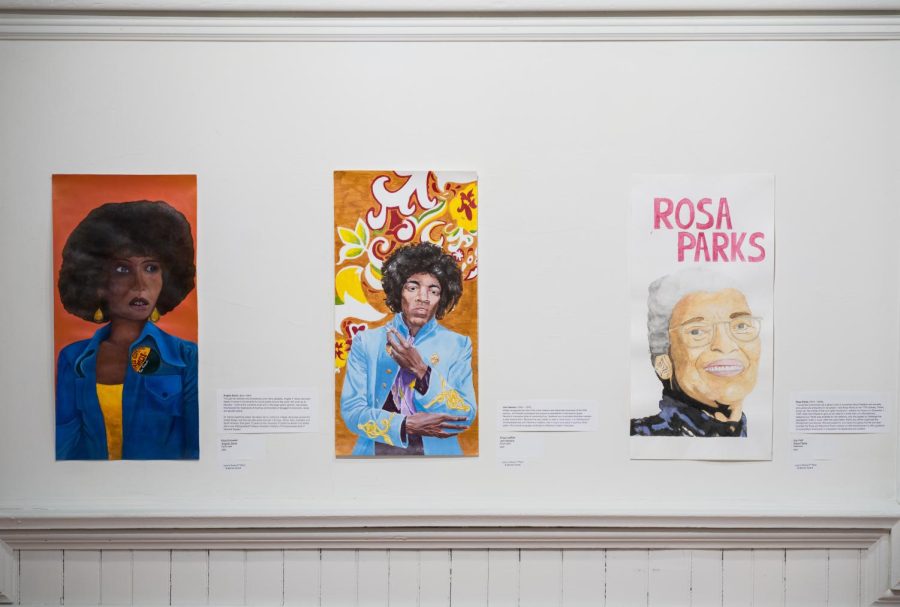Portraits by Oberlin High School Students displayed in Downtown Oberlin to Celebrate Black History Month
Photos by Abe Frato, Photo Editor
Oberlin High School student artists showcase their work at Firelands Association for the Visual Arts.
If you’ve recently walked down Main Street in Oberlin, you may have noticed new banners hanging from street lamps featuring portraits of important figures in Black history. These banners are the work of Oberlin High School students under the guidance of art teacher Mallory Tulcewicz. Students chose important figures from Black history, researched their lives, and created portraits of them. A jury consisting of local artists, community members and educators was chosen by the Firelands Association for the Visual Arts. The jury selected 12 portraits to be reproduced and displayed throughout the City. Additionally, three students were given the Juror’s Choice Award and won a combined total of $410 provided by local donors. All the students’ original artwork is displayed in FAVA’s South Main Street gallery, which is open to the public.
The idea of using Oberlin High School students’ artwork to celebrate Black History Month was originally proposed by Administrative Coordinator of Communications & Human Resources for the city of Oberlin Diane Ramos.
“Given that this is Oberlin and we have a very rich Black history … I wanted to utilize those elements to celebrate Black History Month,” Ramos said. “I approached Kathleen [Jackson, director of FAVA] about the banner project. … She was very excite all about it. So from there I approached the art teacher at the high school. Everyone was excited, and we were able to get the project off the ground.”
High school students have painted banners for Oberlin’s street lamps in the past, but this is the first time the art has been printed on banners, or that the art has been related to Black History Month. The students were allowed to choose what medium they wished to use. Some por-
traits were done in acrylic paint, others in watercolor or charcoal. One incorporates collage.
“Students were given a lot of freedom for the project,” Tulcewicz said. “With my Art I and II, we went over the basics of drawing each facial feature … then we used a grid technique where you can size up the image that you’re drawing.”
The subjects of the portraits include activists, musicians, and athletes. Tulcewicz said that she, Jackson, and Ramos compiled a list of important figures for the students to choose from using resources such as the 1619 Project. Some portraits are of nationally-known figures like Martin Luther King Jr., Jimi Hendrix, and Jesse Owens. Others depict people with connections to Oberlin or Northeast Ohio, including Mary Jane Patterson, the first African-American woman to receive a bachelor’s degree in the United States; Mary Burnett Talbert, civil rights activist and educator; and baseball trailblazer Moses Fleetwood Walker. All three of these individuals attended Oberlin College. Two students chose subjects who are currently important community members in Oberlin: Kurt Russell, an Oberlin High School teacher who was awarded National Teacher of the Year in 2022, and Farah Emeka, a prominent local lawyer and Oberlin School Board President. Russell personally visited his portrait in the gallery.
Both Jackson and Ramos hope this will be a tradition that continues into the future. The banners are reusable and will be hung again next year in other parts of Oberlin, while new banners created by next year’s OHS students will line South Main Street. “We’re excited to use these types of platforms and our connections with the different organizations in town to support Black History Month, but also to support our local artists,” Ramos said. “So I hope that this becomes a new tradition and that we can keep building on these arts related projects.”
FAVA Gallery Director Tirzah Legg added that drawing portraits of important Black historical figures had an educational value for the students involved.
“A lot of artists go through their whole career painting portraiture, and … they don’t do Black figures and they don’t understand
the process of how to address that,” Legg said.
Tulcewicz said she felt public art is a great way to showcase the work of young artists and show that their art is valued.
“It’s also important for [students] to see that art has more than just a purpose of sitting on a wall,” she said. “It can be shown locally, and public art gives people the opportunity who normally don’t have the ability to go to a museum or to travel somewhere.”
The banners will hang on South Main Street and throughout Oberlin until March 5.










